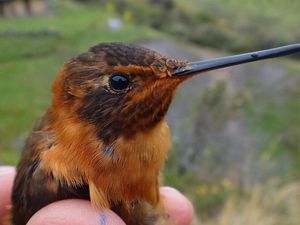‘Larger hummingbirds use muscle power to outperform smaller species’
Scientists filmed around 200 hummingbirds and recorded more than 330,000 manoeuvres.

Larger hummingbirds use their muscle power and wing size to outperform their smaller counterparts, new research suggests.
Scientists found that, despite their size, larger hummingbird species are able to outmanoeuvre smaller birds by relying on their muscle capacity – the endurance, strength, and power of muscles – and wing loading – the ratio of the wing area compared with body mass.
Study leader Roslyn Dakin, of the University of British Columbia, said: “Studies of bats, birds and other animals show that increases in body mass can have a detrimental effect on many aspects of flight.
“But with hummingbirds, the correlated evolution of increased wing size and muscle mass helps larger species compensate for their greater body masses.”
The researchers filmed more than 200 hummingbirds from 25 Central and South American species. A computer tracking system recorded their movements.

Paolo Segre, co-author of the study and a postdoctoral researcher at Stanford University, said: “We recorded over 330,000 manoeuvres, including many repeated manoeuvres for each bird.
“Capturing that much data was a challenge. Our first field site was at a biological reserve deep in the Peruvian Amazon, an area with many species of hummingbirds, but only accessible by boat.
“We ran our computers and cameras using solar panels and generators in a thatched hut with strategically placed rain buckets!”
The authors found that the hummingbirds’ muscle capacity was associated with better acceleration whereas manoeuvres involving rotations and turns were driven mainly by wing loading.

The team also found that skill played a role in the hummingbirds’ flying agility.
Douglas Altshuler, of the University of British Columbia, and co-author of the study, said: “The hummingbirds tend to play to their strengths, especially with complex moves.
“For example, species that have the ability to power through turns tend to use more arcing trajectories, and they shy away from performing turns in which they decelerate to turn on a dime.”
The research is published in the journal Science.





